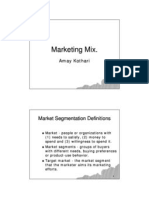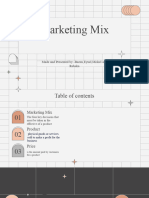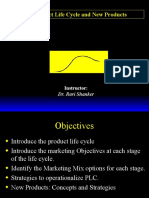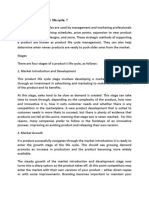0 ratings0% found this document useful (0 votes) 44 views9 pagesMSC 731 October 2nd Note
Copyright
© © All Rights Reserved
We take content rights seriously. If you suspect this is your content,
claim it here.
Available Formats
Download as PDF or read online on Scribd
MARKETING
‘The most basic concept underlying marketing is that of human needs.
ds
Customer Wants, & Der
= Needs - state of felt deprivation including physical, social, and individual needs.
= Wants - form that a human need takes, as shaped by culture and individual personality.
= Demands — wants backed by buying power.
= People demand products/services with benefits that add up to the most value &
satisfaction.
ing & delivering offerings(products/services)
Marketing is the process of creating, communi
that have value for customers.
MARKET
Isa set of actual & potential buyers of a products/services
CUSTOMER
‘Who purchases products or services from the businesses in exchange for money
= Marketing facilitates exchanges that will satisfy individual and organizational
objectives.
= Requirements for exchange:
‘Two or more parties
Parties have something of value to exchange
Each party has something other party wants
Means of communication & delivery�Communication
Industry Goods/Services ef
(a collection (a collection
| of sellers) of buyers)’ «
Information
Five key concepts form the foundation of marketing:
+ The production concept
+ The product concept
+ The selling concept
+ The marketing concept
* The societal marketing concept
The Production Concept
‘= This concept holds that consumers will prefer products that are widely available and
inexpensive.
' Managers focusing on this concept concentrate on achieving high production effici
low costs, and mass distribution.
iency,
© Ford - Model T
The Product Concept
‘= This orientation holds that consumers will favor those products that offer the most
uality, performance, or innovative features,
‘Managers focusing on this concept concentrate on making superior products and
improving them over time.
Apple is a prime example of this concept in action. Its target audience always eagerly
anticipates the company’s new releases,�The Selling Concept
© Itholds that consumers, if left alone, will ordinarily not buy enough of the company’s
products.
= The organization must, therefore, undertake an aggressive selling and promotional
effort.
= The selling concept is centered on the belief that you must convince a customer to buy a
product through aggressive marketing of the benefits of the product or service.
= Insurance companies
‘The Marketing Concept
= It’sall about knowing the target market, sensing its needs, and meeting them most
effectively.
= Many refer to this as the “customer-first approach.”.
= Sony Walkman
The Societal Marketing Concept
= This concept emphasizes focusing on meeting customers’ needs in a way that preserves
or enhances the consumer’s and the society’s well-being.
© The fast-food industry is an example of what the societal concept aims to address.
There’s a high demand for fast food, but this food is high in fat.
‘The 4 Ps of Marketing (Marketing Mix)
= The four Ps are combined tools that marketers use to achieve their marketing objectives.
= They are:
Product
Price
Place
Promotion�Product
= The product is what a company sells.
= Successfill products fill a need not currently being met in the marketplace or provide a
novel customer experience that creates demand.
= Eg: the iPhone filled a need in the market for a simplified device that paired a phone with
an iPod.
= Some questions to consider when working on a product include:
+ Does the product meet an unfilled need or provide a novel experience?
* Who is your product’s target audience?
+ How is your product different from what others offer?
© Price is the cost of a product/service.
= Price is the amount that consumers will have to pay for a product/service.
= To identify a successful price, marketers will want to thoroughly understand the target
audience and their willingness to pay for the product/service.
= Some questions to consider the product's price include:
+ Whats the price of your product’s competitors?
+ What price is too high for your audience? What price is too low?
= Place is where a company sells the product and the distribution channels used to get it to
the customer.
= To decide the best place to sell the product, a marketer should consider researching the
physical or digital places where the target audience shops.
Promotion
= Promotion means activities that communicate the merits of the product/service &
persuade target customers to buy it.
m= There are many different ways to promote your product: Advertising, Sales Promotion,
PR, Personal Selling, Direct Marketing.�Some questions to consider on promotion include:
‘Which media are most effective for your target audience?
‘What advertising approaches are most persuasive to your target audience?
PRODUCT LIFE CYCLE (PLC)
‘The Product Life Cycle(PLC) involves the stages through which a product goes from
the time it is introduced in the market tll it leaves the market.
‘The concept of the product life cycle is fundamental to understanding how the product
will evolve over time.
PLC consists of four stages:
Introduction
Growth
Maturity
Decline�PRODUCT LIFE CYCLE
SALES
INTRODUCTION STAGE
During this stage, the product is released into the market for the very first time.
At this stage the product is unknown and the business needs to advertise it to create
demand.
Company makes substantial investment in advertising and a marketing campaign focused
on making consumers aware of the product and its benefits.
The business still makes a loss, as the small number of sales do not yet cover the money
spent on research and development.
Some examples of products currently in the introduction stage include:
Self-driving cars
3D televisions
GROWTH STAGE
During the growth phase, the product becomes more recognizable.
This is characterized by growing demand, an increase in production, and expansion in its
availability.
This is where sales show their most rapid growth.
Profitability begins to rise.
Costs reduced due to economies of scale.
Competition begins to increase with a few new players in establishing market.
Some products that are currently in the growth stage are:
Smartwatches, Electric cars�A’ STAGE
‘The product reaches its peak sales and is at its most profitable point for the company.
With the market saturated with the product, competition now higher than at other stages.
Sales levels stabilize.
‘The profit margins start to shrink.
‘The originator is forced to appeal to the consumer on the basis of price, product
differences, or both.
Product modifications.
Examples:
‘Smartphones
Video game consoles
DECLINE STAGE
When market maturity tapers off and consequently comes to an end,
decline stage.
Product sales begin to drop due to market saturation, change in consumer behavior, and
alternative products.
the product enters
‘The prices & margins get depressed, total sales & profits diminish.
‘The company may choose to not pursue additional marketing efforts.
Eventually, the product retires from the market.
Examples of products in the decline stage:
Typewriters
Landline telephones
DVDs�Adoption
= Types of Customers
25%
Innovators: Early
Adopters Laggards
135% 1%
Innovators:
= They tend to be younger, better educated, cosmopolitan, & more socially mobile than
peers,
Risk takers.
= Eagemess to try new products/services; love exploring,�Early Adopters:
They are successful, & well educated,
Willing to take calculated tisk,
Influencers.
Early majority:
They tend to be older than innovators & early adopters, & less socially mobile than early
adopters.
Cautious about innovations.
Adopt innovation after the innovation has proved successful with others.
Late Majority:
‘They tend to be older & of less social status than those who adopt earlier.
Skeptical about innovations.
Laggards
Tend to be dogmatic.
Adopt innovations only with reluctance.
They adopt innovation when it has become old.






























































